Architecture Matters
Visit my NEW site Alexandra Eidenschenk Designs

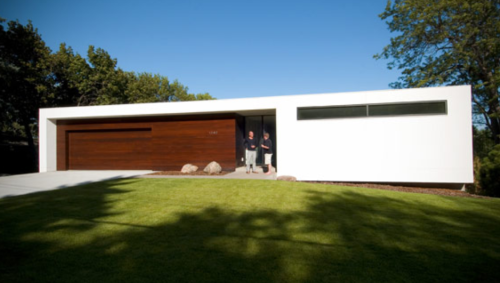
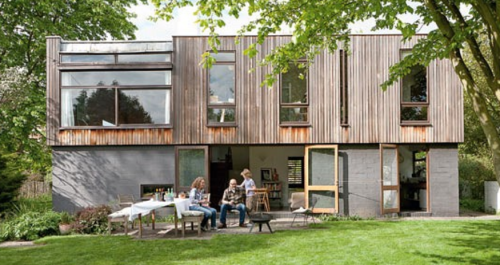 I’ve noticed in the past few years a number of highly modernistic houses being built where I live in New Marlborough, MA, and in neighboring towns. In my opinion, it’s an unfortunate trend! Modernism is totally at odds with the bucolic, rural, traditional New England look and feel of the Berkshires with its many 18th and 19th century houses and picturesque town centers.
I’ve noticed in the past few years a number of highly modernistic houses being built where I live in New Marlborough, MA, and in neighboring towns. In my opinion, it’s an unfortunate trend! Modernism is totally at odds with the bucolic, rural, traditional New England look and feel of the Berkshires with its many 18th and 19th century houses and picturesque town centers. 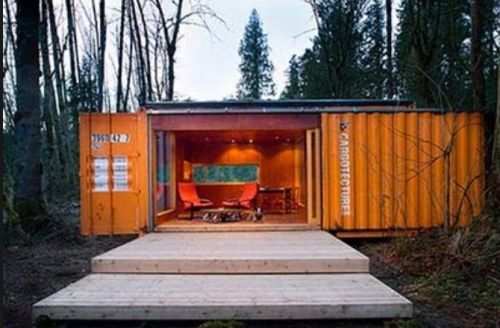 Now this issue of modernism has come right to my own doorstep and I feel compelled to speak out. New neighbors down the road want to build a house that I can only describe as a “boxcar with a roof” — one story, with horizontal picture windows that don’t open, no trim, and wrapped in black metal with a shallowly pitched eave-less roof – all hallmarks of modernist architecture.
Now this issue of modernism has come right to my own doorstep and I feel compelled to speak out. New neighbors down the road want to build a house that I can only describe as a “boxcar with a roof” — one story, with horizontal picture windows that don’t open, no trim, and wrapped in black metal with a shallowly pitched eave-less roof – all hallmarks of modernist architecture.
Architecture is a public issue as much as a private one. I believe that architectural decisions affect our well-being as humans by enhancing or detracting from our sense of community. Clearly the architects and designers in these photos below intended to provoke a reaction with these buildings that don’t look anything like what’s around them. They were not designed harmoniously and have therefore made a clear statement of “separate-ness.” Do any of these photos make you feel good? Would you want them in your neighborhood?



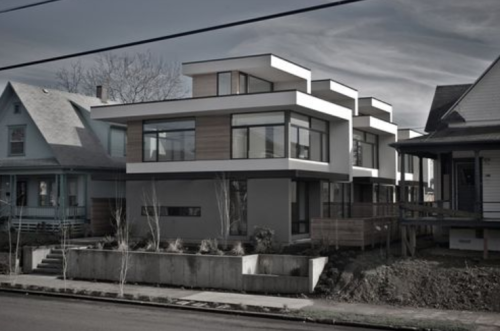
Whether you like the style or not, modernist architecture doesn’t even make sense in this part of the country. Building practices in New England developed over several hundred years as settlers learned to manage the harsh climate. Wood allows homes to breathe. Windows with sashes were designed to open at the top and bottom to promote airflow, drawing air in from the bottom and pushing heat out at the top. 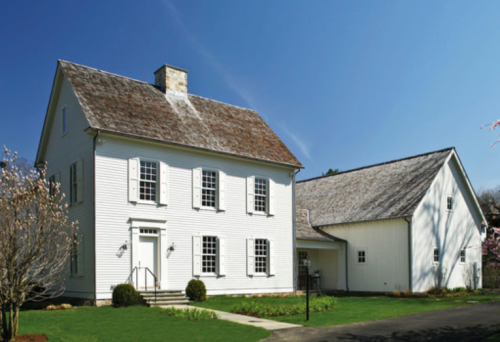 Roofs are generally steeply pitched in order to minimize snow loads and so that snow can slide off easily. Eaves and decorative caps shelter wood clapboards and windows from rain and prevent rotting. After being erected, traditional timber frames are left for months to “weather” before siding and roofing is applied, so that the structure can become part of the climate – the ultimate in harmonic building practices.
Roofs are generally steeply pitched in order to minimize snow loads and so that snow can slide off easily. Eaves and decorative caps shelter wood clapboards and windows from rain and prevent rotting. After being erected, traditional timber frames are left for months to “weather” before siding and roofing is applied, so that the structure can become part of the climate – the ultimate in harmonic building practices.
Another argument in favor of modernism is about minimizing the environmental impact of building. But what is the definition of “green”? Local grocery stores have banned the use of plastic bags but it’s ok to wrap your house in metal? 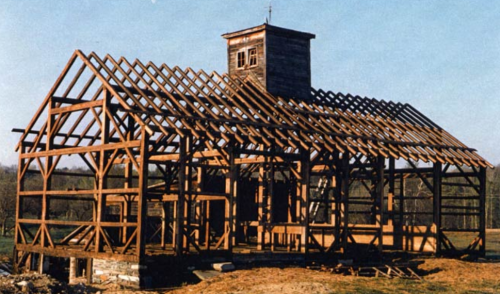 In a fire, man-made metal framing and adhesive-laced building materials, the basic building blocks of modernism’s glass and steel construction, burn far hotter and cause far more destruction than anything built out of wood. Old time timber framers chamfered the beams so that they would have a harder time catching fire and even today you can see skeletons of old wooden barns still standing – after several hundred years. Wood is indeed the ultimate sustainable material.
In a fire, man-made metal framing and adhesive-laced building materials, the basic building blocks of modernism’s glass and steel construction, burn far hotter and cause far more destruction than anything built out of wood. Old time timber framers chamfered the beams so that they would have a harder time catching fire and even today you can see skeletons of old wooden barns still standing – after several hundred years. Wood is indeed the ultimate sustainable material.
This is not, as some contrarian friends and townspeople think, about individual taste. I am a devoted student of architecture and I can appreciate a variety of architectural styles. But I object to individuals who feel it is their right to completely change the look and feel of their neighborhood with their own personal style. If you want to live in a modern home, why pick a historic neighborhood? To me, it feels very much like they want to make a statement of individuality more than they want to honor their chosen neighborhood.
 Architecture matters. I named my company Design First because to me, it’s all about the design. And the design process starts by examining your surroundings and learning from tried and true practices in your geographical area before you build. What kind of homeowner do you want to be — one who honors the building practices and traditions of the community you chose to live in, or one who decides that your neighbors don’t matter?
Architecture matters. I named my company Design First because to me, it’s all about the design. And the design process starts by examining your surroundings and learning from tried and true practices in your geographical area before you build. What kind of homeowner do you want to be — one who honors the building practices and traditions of the community you chose to live in, or one who decides that your neighbors don’t matter?

I love Frank Lloyd Wright – and Falling Water… and so I have to disagree on some level… There is modern architecture that can enhance and make the land important – apart from a farm house… and we have new architects today who have vision for houses that fit the land that may not fit into our idea of the past.
I also think that families evolve and what they need and want evolves – and although I love the idea of a family living in an 1800 or 1900 barn – it won’t look like that on the inside – so why shouldn’t it evolve on the outside?
Just thinking… I like new things… new ideas coming to our area… some will work, some won’t… we’re not Litchfield… thank God….
Alexandra, i don’t believe we have met yet it seems like we live in the same town and care about ,any of the same things! I am so pleased that you are so enthusiastic about architecture, New Marlborough, and context. I live on Clayton Mill River Road in a170 year old house that has seen many owners and alterations. There are parts of the house that reveal their origins in the 1850s, the 1930s, the 1960s, the 1980s, and now 2017. It’s a challenge, when planning some work, which era to refer to. The only answer, and it is the answer that all of our forbearers came to, is to make your intervention of your own time with due respect (or not!) to the existing. That is evident throughout New England. A thorough investigation into the history of building in our region would reveal this complex and delightful truth. An example I am most fond of in our town is at the intersection of Hartsville Mill River Road and Adsit Crosby Road. The house is clearly from several era and it is all the lovelier for that. Another more recent example is a project now being undertaken at the corner of Clayton Mill River Road and Brewer Hill Road. It’s an old brick house seemingly from the early 19th century with an addition from who knows when and. a barn from about that time. The work is careful, loving and correct, but speaks totally of our time. I aspire to that in our home.. If one is presented with an intact historical structure, of which there are a rare few examples of I our region, the direction is clear: preserve it so all of our neighbors can fully realize from where things have come. I very much appreciate your discussion of the public nature of architecture and it’s role in a community. However, I must strongly disagree with your comments on new buildings. Why would we mimic the forms, materials, shapes, styles, layouts, or construction techniques of the past any more than we would mimic the social structures, laws, norms, oppressions or limitations of the past? I think there is beauty in all good architecture In fact, I am elated that we seem to be in a golden age of design where beautiful, sensitive, exciting buildings are being made that both respect their environment and meet current tastes and modes of living. I am currently working on a renovation of an 1860s farmhouse that had a rather clumsy 1960s addition made to it. Frankly, the 1860 portion is rather clumsy itself and likely to been built , as was the 20th century addition, by its residents. So, the story of this home is one of farmers, with a necessity, resources,, and capability, though little or no training, built, added to, modified, expanded, altered,, renovated, and most of all, claimed for themselves and their time, a physical container they called home. I feel that to slavishly and sentimentally reproduce, but with a killer kitchen, double pane windows and central air conditioning, a historical home reveals an insecurity about the quality of our current architecture, a misunderstanding of the history of architecture and a sentimental view of history. I am quite sure that you are doing good, quality work and I would much rather see good quality, faux houses than crappy fancy nonsense (look in GB and Egremont) but that is a false choice. There are many exceptional,modern homes, and buildings of all types, that speak to us in today’s language, are broadly appreciated, and that sit comfortably beside those that did the same hundreds of years ago. I look forward to meeting you someday and getting better acquainted with your work.
Dan Doern
Dan – Thanks for the nice words about my house. I too love that brick house renovation near your own home. It’s elegant and tasteful. I certainly appreciate your feelings about modern architecture. I like it too — when it’s done well. I just think it’s important for people to be respectful of what already exists around them when they are thinking of building. I wouldn’t build a brick Georgian in a neighborhood of glass and steel and it distresses me to think of our lovely New Marlborough being overtaken by boxcar style homes. At least we can enjoy the debate! Please stop by my house sometime. I’d love to meet you. – Alexandra
Alexandra,
You live on the corner of HMRR and Adsit Crosby? That’s a coincidence. I gathered from your blog that you lived on NM Hill Road. I admire your home each time I drive by.
i get distressed by much of what I see on the way to GB but that’s more of a zoning failure – allowing the sides of our country roads to be choked with houses with no thought to how that changes the character of our towns and blocks views to the hills around.
Ok, what do you think of the big house going up on the Freeman Elms property. It seems to be using a barn vocabulary and has some red siding gonig on it.
I look forward to meeting you.
Dan
Wow, that is a coincidence! Really, stop by anytime and I’ll give you a tour. I own land on New Marlborough Hill Road and will start to build a new house in 2019. It will be a small cape much like what I have now but on a much more private lot. I like the concept of the house at the top of County Road but the small horizontal windows aren’t substantial enough for the facade. Fenestration is one of the most important architectural decisions you can make and I wonder if the homeowners didn’t have architectural elevations drawn up before the house was built. But I like the idea of a contemporized barn. It’s modern but still works with the vernacular.